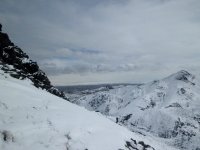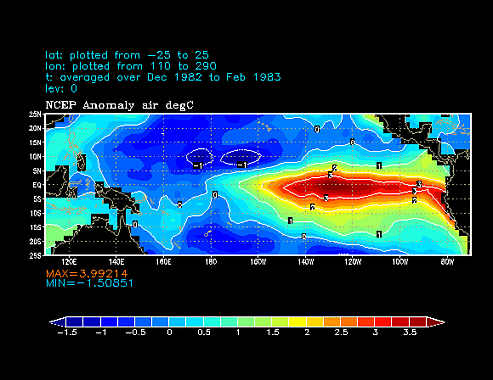-
توجه: در صورتی که از کاربران قدیمی ایران انجمن هستید و امکان ورود به سایت را ندارید، میتوانید با آیدی altin_admin@ در تلگرام تماس حاصل نمایید.
You are using an out of date browser. It may not display this or other websites correctly.
You should upgrade or use an alternative browser.
You should upgrade or use an alternative browser.
مباحث عمومی هواشناسی
- شروع کننده موضوع Amir Mohsen
- تاریخ شروع
- وضعیت
- موضوع بسته شده است.
Amir Mohsen
متخصص بخش هواشناسی
سلام و صبح بخیر
فرودگاه مشهد هم در سرد ترین ساعات دمای 3- زیر صفر رو ثبت کرده و بنظر با این دید افقی 100 متر تمام پروازهای بامداد امروز فرودگاه مشهد باید لغو شده باشه.
دمای فعلی 1- زیر صفر

Sent from my SM-N900 using Tapatalk
فرودگاه مشهد هم در سرد ترین ساعات دمای 3- زیر صفر رو ثبت کرده و بنظر با این دید افقی 100 متر تمام پروازهای بامداد امروز فرودگاه مشهد باید لغو شده باشه.
دمای فعلی 1- زیر صفر

Sent from my SM-N900 using Tapatalk
وحید - مشهد
کاربر ويژه
بارش تجمعی 192 ساعت آینده


به گزارش آناج، ارسلان هاشمی با بیان اینکه تراز سطح آب دریاچه ارومیه 1270/40 متر و وسعت فعلی آن 3300/68 کیلومتر مربع است؛ گفت: حجم آب موجود در دریاچه ارومیه در آبان ماه (سال 92) سال جاری 11/12 میلیارد متر مکعب است.
وی افزود: حجم آب دریاچه ارومیه در سال 92 از 12/18 به 11/12 نسبت به سال 91 ، 1/06 میلیاد متر مکعب کاهش پیدا کرده است.





وی افزود: حجم آب دریاچه ارومیه در سال 92 از 12/18 به 11/12 نسبت به سال 91 ، 1/06 میلیاد متر مکعب کاهش پیدا کرده است.





مطابق با جدیدترین اطلاعات این بیم و امید وجود داره انسو به صورت ناگهانی وارد فاز مثبت قوی بشه و پدیده super elnino رخ بده
Sent from my SM-N900 using Tapatalk
محسن جان سلام
حالا در صورت وقوع این برای ادامه بهار خوبه یا بد؟؟
seyyedalireza
مدیر موقت
امروز صبح هیچی دیده نمیشد چه مه ی بود
Amir Mohsen
متخصص بخش هواشناسی
محسن جان سلام
حالا در صورت وقوع این برای ادامه بهار خوبه یا بد؟؟
سلام آرش جان
تبعات وقوع این پدیده در نقاط مختلف ایران و و در طول ماههای مختلف و خصوصا فصل بهار که همینک در اون هستیم باید مورد بررسی قرار بگیره.
آخرین سوپر النینو در بازه زمانی 1997 -98 میلادی بوقوع پیوسته و عملا خیلی از کارشناسان دارن پدیده النینوی پیشرو با اون سال مقایسه میکنند.
میشه به سایت چهار محال بختیاری مراجعه کرد و وضعیت جوی مثلا مشهد رو در همون سال مورد بررسی قرار داد و یا میشه از سایت NOAA آنومالی های اون سال و یا سالهای مشابه رو برای ایران استخراج کرد.
Amir Mohsen
متخصص بخش هواشناسی
با سلام و تقدیر و تشکر از کار تحسین بر انگیز دوستان انجمن خصوصن مهندس امیر محسن عزیز که باز هم خوش درخشید :گل:
چند تا عکس از ارتفاعات جنوب مشهد (هاشمیه) را که دیروز قبل از ظهر گرفتم را مشاهده پیوست 54753مشاهده پیوست 54760همرا با احترام تقدیم میکنم:احترام:
درود بر مهندس فربد عزیز
ضمن تبریک عرض سال نو خدمت شما .:گل:
از لطف بیکرانت تون بسیار سپاسگذارم.
راستی عکسهای ارسالی فوق العاده زیبا و گویای فروردین برفی و سرد مشهد بودند.:گل:
سلام آرش جان
تبعات وقوع این پدیده در نقاط مختلف ایران و و در طول ماههای مختلف و خصوصا فصل بهار که همینک در اون هستیم باید مورد بررسی قرار بگیره.
آخرین سوپر النینو در بازه زمانی 1997 -98 میلادی بوقوع پیوسته و عملا خیلی از کارشناسان دارن پدیده النینوی پیشرو با اون سال مقایسه میکنند.
میشه به سایت چهار محال بختیاری مراجعه کرد و وضعیت جوی مثلا مشهد رو در همون سال مورد بررسی قرار داد و یا میشه از سایت NOAA آنومالی های اون سال و یا سالهای مشابه رو برای ایران استخراج کرد.
درود...... :گل:
مگه النینوی سال 2010 النینوی خیلی قوی نبود؟ سوپر النینو یعنی قوی تر از اون؟
Amir Mohsen
متخصص بخش هواشناسی
درود...... :گل:
مگه النینوی سال 2010 النینوی خیلی قوی نبود؟ سوپر النینو یعنی قوی تر از اون؟
درود بر شما
ظاهرا اون سال قویتر بوده منظورم سال 97-98 میلادی !
[SIZE=+1] 1997-1998 El Niño
the most recent event The most recent El Niño event began in the spring months of 1997. Instrumentation placed on Buoys in the Pacific Ocean after the 1982-1983 El Niño began recording abnormally high temperatures off the coast of Peru. Over the next couple of months, these strength of these anomalies grew. The anomalies grew so large by October 1997 that this El Niño had already become the strongest in the 50+ years of accurate data gathering.
The image below displays the Sea Surface Temperature (SST) Anomalies in degrees Celsius for the middle of September, 1997. By this time, the classic El Niño pattern has almost fully ripened, with maxima above +4 degrees Celsius.

[/SIZE]The image below displays the Sea Surface Temperature (SST) Anomalies in degrees Celsius for the middle of September, 1997. By this time, the classic El Niño pattern has almost fully ripened, with maxima above +4 degrees Celsius.

Amir Mohsen
متخصص بخش هواشناسی
A super El Niño on the way? Subtle signs emerging
 Visualization of El Nino (NOAA)
Visualization of El Nino (NOAA)
Mashable’s Andrew Freedman has penned an intriguing and important piece suggesting the possible El Niño in the pipeline may be a doozy, comparable to the strongest ever recorded:
Freedman interviews two scientists, Eric Blake from the National Hurricane Center and Paul Roundy from SUNY-Albany, who see early indicators reminiscent of the development stages of past whopper El Niño events.
One important possible indicator of the lead up to an El Niño is a reversal in the trade winds observed in the equatorial Pacific, from a prevailing easterly (from the east) to westerly (from the west) direction. In recent weeks and months, there have been strong westerly “bursts”.
From Freedman’s piece:
Separately, meteorologist Michael Ventrice from Weather Services International, discusses a possible related harbinger of a big El Niño: a powerhouse eastward push of water, known as a Kelvin wave, under the sea surface. This kind of underwater wave, triggered by the westerly wind bursts, is key for transporting warm water from the west Pacific to the east Pacific and getting an El Niño event underway. But Ventrice stresses it needs some additional propulsion:
Suppose a strong El Niño event does materialize later this summer or fall. What might it mean?
- [h=6]By Jason Samenow
- [h=6]March 20 at 3:47 pm

Mashable’s Andrew Freedman has penned an intriguing and important piece suggesting the possible El Niño in the pipeline may be a doozy, comparable to the strongest ever recorded:
Since climate forecasters declared an “El Niño Watch” on March 6, the odds of such an event in the tropical Pacific Ocean have increased, and based on recent developments, some scientists think this event may even rival the record El Niño event of 1997-1998.
Recall an El Niño event is an episodic warming of the eastern tropical Pacific ocean, which often has worldwide weather implications.
Freedman interviews two scientists, Eric Blake from the National Hurricane Center and Paul Roundy from SUNY-Albany, who see early indicators reminiscent of the development stages of past whopper El Niño events.
One important possible indicator of the lead up to an El Niño is a reversal in the trade winds observed in the equatorial Pacific, from a prevailing easterly (from the east) to westerly (from the west) direction. In recent weeks and months, there have been strong westerly “bursts”.
From Freedman’s piece:
“It’s something we haven’t really seen since the ’97 El Niño,” Blake said of the westerly wind bursts and ocean observations. Instead of having trade winds blowing from the east at five to 10 mph, some locations in the western Pacific have had winds from the west blowing at up to 30 miles per hour, Blake says. This is important because it has ripple effects on the sea and below the sea surface.
So impressed by the strong and persistent westerly winds, Roundy told Freedman he thinks there’s “around” an 80 percent chance of an unusually strong El Niño.
Separately, meteorologist Michael Ventrice from Weather Services International, discusses a possible related harbinger of a big El Niño: a powerhouse eastward push of water, known as a Kelvin wave, under the sea surface. This kind of underwater wave, triggered by the westerly wind bursts, is key for transporting warm water from the west Pacific to the east Pacific and getting an El Niño event underway. But Ventrice stresses it needs some additional propulsion:
The current Kelvin wave in the Pacific Ocean has achieved the same strength as the one that preceded the 1997 Super El Niño event. This is an extremely rare feat but there still has to be a number of things to happen before we can say we are headed towards a strong El Niño. We need to see the continuation of strong westerly winds near the Equator over the Central Pacific to keep the momentum forward.
In Freedman’s piece, Blake and Roundy emphasize that a strong El Niño is no sure thing. They point out the westerly winds could relax halting the El Niño’s formation. Tony Barnston, a climate forecaster at the International Research Institute for Climate and Society (IRI), offers Freedman this cautious assessment:
Unless we continue to get westerly wind events in the coming weeks, there is no guarantee that it will be a big event, and there is a 40% or so chance we will not get an El Niño at all
Officially, NOAA says there is just over a 50 percent chance of an El Niño of any variety, weak, moderate or strong. (Note: the normal chance of an El Niño would be 33 percent, since its parent weather pattern known as the El Niño Southern Oscillation or ENSO, has three phases: El Niño, La Niña, and neutral).
Suppose a strong El Niño event does materialize later this summer or fall. What might it mean?
- Large amounts of heat from the tropical Pacific ocean would be released into the atmosphere, likely raising global temperatures to record-setting levels
- Above normal rain would be favored in California.
- Hurricane activity would likely be suppressed in the Atlantic
- Washington, D.C. might see depressed snow next winter. Our two least snowy winters on record (0.1 inches at Reagan National Airport) coincided with two of the three strongest El Nino events on record (1997-1998 and 1972-1973).
- Link: List of El Niño impacts on North America
Amir Mohsen
متخصص بخش هواشناسی
تصاویری از دشت شمالی مشهد و دامنه های مرکزی رشته کوههای هزار مسجد- اژدر کوه- کارخانه سیمان مشهد- ظهر یکشنبه سوم فروردین 1393 ساعت 14:00
توضیح :بیلبرد های تبلیغاتی مزاحم در این تصاویر حذف شده اند!









توضیح :بیلبرد های تبلیغاتی مزاحم در این تصاویر حذف شده اند!









سلام آرش جان
تبعات وقوع این پدیده در نقاط مختلف ایران و و در طول ماههای مختلف و خصوصا فصل بهار که همینک در اون هستیم باید مورد بررسی قرار بگیره.
آخرین سوپر النینو در بازه زمانی 1997 -98 میلادی بوقوع پیوسته و عملا خیلی از کارشناسان دارن پدیده النینوی پیشرو با اون سال مقایسه میکنند.
میشه به سایت چهار محال بختیاری مراجعه کرد و وضعیت جوی مثلا مشهد رو در همون سال مورد بررسی قرار داد و یا میشه از سایت NOAA آنومالی های اون سال و یا سالهای مشابه رو برای ایران استخراج کرد.
خیلی ممنون محسن جان
وحید - مشهد
کاربر ويژه
- وضعیت
- موضوع بسته شده است.

















